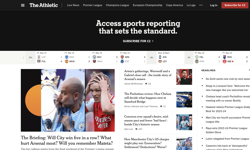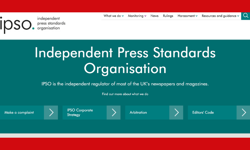Received wisdom views newspapers as a medium in long-term decline, with modern lifestyles and digital media irreversibly eroding their circulations. If that is true, is not management at the Guardian being somewhat reckless in investing a reputed £80m in changing from its traditional broadsheet size to the Berliner format? Given the famed strength of the Guardian’s digital media, such as Guardian Unlimited, and the launch of the Guardian Sports Show on Channel 4, would they not be better off to accept that newspapers have had their day and to focus such investment into these electronic channels?
Early sales boost
Guardian management, however, clearly believes otherwise and is particularly positive about the results of their format change on September 12th, which also involved repositioning the paper. "It’s very early days, but the response to the relaunch has been very exciting," says Bob Steadman, deputy circulation director at the Guardian. In the first week, sales were 30% up, indicating a high level of trial, and September’s ABC was ‘terrific’ with a sale up 11.5% breaching the 400,000 level despite the withdrawal of 15,000 bulks. "It would seem," says Steadman, "that we have created an attractive product which is appealing to new audiences as well to as our existing readers – who have been particularly positive about the change." This favourable view is echoed by many in the wider newspaper industry. Paul Woolfenden, managing director of the Business and media guru, says "it is a superb product that gives one permission to reappraise the Guardian despite one’s previous perceptions of it." This strategy, according to Dan Sabbagh of the Times, appears to be working with the gain in sale coming from "former and occasional readers returning to the fold."
Encouraging trial
It is clear that the newspaper is striking out from its traditional territory - from ‘indulgent socialism’ in the view of some critics – to attract a wider readership. "The whole exercise is indeed about trial and reappraisal," confirms Marc Sands, marketing director. "The aim was to strengthen our relationship with our core readers but also to give the marketplace a new opportunity to sample our product - the whole object was to overcome preconceptions. So you will find in your new Guardian the broadest views and opinions from left to right, from highbrow to lowbrow, with writers you wouldn’t expect – like Simon Jenkins (previously an editor of the Times), William Hague and Max Hastings, as well as those you would, like Polly Toynbee."
Broadsheet echoes
The new design and format is certainly striking. The paper is the width of a compact/tabloid, which makes it manageable when commuting, but with the height of a broadsheet. This echo of the newspaper’s broadsheet origins is important. Says Sands, "we did a lot of research which told us clearly that a newspaper presented with a fold carries weight and authority in a way that a tabloid size does not." Moreover, the format, although narrower, still allows variety on the front page, when the traditional compact/tabloid is limited in the stories it can cover.
On opening the paper, it is clear how the availability of colour on every page has influenced its page design, which is as much colour magazine as traditional newspaper, and supported an adventurous use of space. Particularly arresting is the daily double–page colour photograph in the "Eyewitness" section, almost a poster size picture, portraying subjects as controversial as the experience of those involved in the New Orleans floods or the spectacle of the new Wembley stadium in construction. The additional sports coverage is also evident. "Instead of a sports section twice a week we now have 12 pages a day - and in full colour," observes Sands.
Staying true
The traditional Guardian values remain however. Evident is the willingness of the newspaper to give the opposing view, on September 21st for example giving prime space in their ‘response column’ to the managing director of the controversial Gate Gourmet company during its industrial dispute at Heathrow. ("It was the wildcat strikers who were unscrupulous and uncaring.") Openness and a strong dialogue with readers are also important priorities. Says Steadman, "we continue to print our ‘Corrections and Clarifications’ column, our journalists publish their email address for response and we employ Ian Mayes, our ‘reader’s editor’ to act as an ombudsman on behalf of our readers. We seek to give our readers every opportunity to interact and identify with their newspaper, and to build their trust in it."
The relationship with the individual reader is clearly of much and increasing importance to the Guardian. Sands describes the big newspaper brands, particularly the Guardian, Daily Telegraph, Daily Mail and the Sun as being particularly iconic and powerful, and generating much loyalty and personal identification. Such a presence is, paradoxically, increasingly valuable in this fragmented multimedia age. Sands explains how the newspaper brand holds the centre ground of the business. "The Mother-ship has to be the finest thing imaginable for the satellites to flourish, so we cannot under-invest in the paper."
Database marketing
If relationships are so important, what is the Guardian’s attitude to database marketing to develop individual contact and communication with readers and prospects? Will the Guardian, for example, seek to emulate the subscription programmes of the other national papers like the Daily Telegraph and Times? Probably not. "We have researched subscription and it may be that traditional subscription programmes will not be for us," says Steadman. Typically, newspapers with such subscription strategies have focussed on winning trial from readers of competing titles, through multi-million piece direct mail campaigns, but trial is not the problem for the Guardian. Says Steadman, "our concerns are not so much about acquisition but more about retention." The relaunch has clearly generated interest from a new audience, and, like other national newspapers, the Guardian has not been slow to use the popular and successful ‘free DVD’ promotion to win trial. Two such promotions in September resulted in two successive record breaking sales for the paper.
Clearly – particularly with the new launch – the problem is not trial but converting triallists to a more regular habit. The first step, therefore, will be to gather the details of triallists and to grow a dialogue with them. The Guardian has the infrastructure for this, including an Oracle database holding comprehensive details of individual readers.
The Guardian is unusual in possessing a head of customer relationship management, who is Charles Ping (the current chairman of the Direct Marketing Association). Ping describes the Guardian’s strategy as ‘creating communities’ around particular topics, such as sport, food and music and interacting with them. Ping describes how sports fans receive an emailed reminder service of coming sporting events and the opportunity to receive the Fiver, again through email. The Fiver, says Ping is "a daily look at football news - a bit left field and chatty - like a fanzine which is hugely well read and followed." Readers can also access an online realtime commentary of selected football matches and can join the roundtable discussions taking place over the web.
Integrated management
Guardian management give the impression of being part of an integrated team comfortable with long term planning. This is not always the norm in newspapers, where the culture is normally short term and operational in focus - geared to its 24 hour cycle - and where operational excellence has bred functional silos that act in isolation. Such cultures are not good at change or able to think strategically for the longer term in a joined-up way. It is clear that much effort has been made at the Guardian to integrate management and to produce a plan that everyone supports. The relaunch was certainly not a knee-jerk response to competitor action.
The commissioning and building of the new presses, supplied by MAN Roland, was completed within an astonishingly fast time frame of less than a year, when most industry experts suggested it would take at least three. Communicating change externally to suppliers and clients, and internally, was a priority throughout the process and it allowed management to create a unified sense of direction and purpose. Great efforts were made to avoid the isolation of vertically structured departments by integrating management members into a team and involving them in the wider aspects of the business. "While we have specific areas of expertise, we like to think of ourselves primarily as Guardian managers," says Bob Steadman.
Management at the Guardian, therefore, clearly see their title ‘bucking the trend’ (as Marc Sands describes it) and fulfilling a vital, flag-carrying role in a rapidly developing age of electronic media – if only because electronic media does not yet offer the commercial return of newspapers. But the internet is fast attracting significant advertising expenditures and will be bigger than commercial radio and consumer magazines combined by the end of 2006. It will be fascinating to see how the printed word will fare in this new commercial world.
FEATURE
Relaunching the Guardian: creating relevance in the electronic age
The 12th of September 2005 saw the long awaited and heavily hyped relaunch of the Guardian in its new Berliner format. Tony Coad talks with senior managers at the Guardian to get their inside view.










